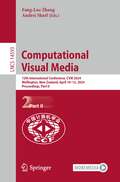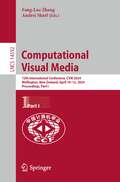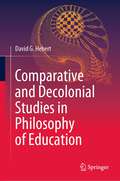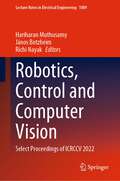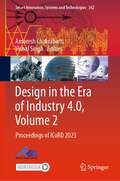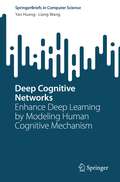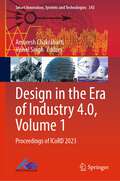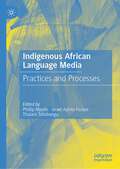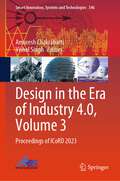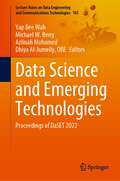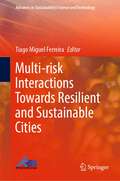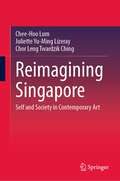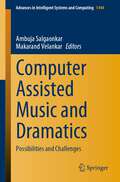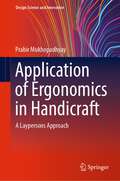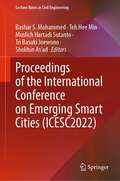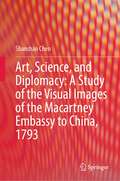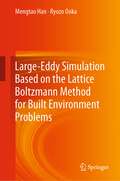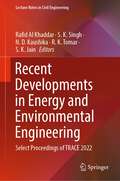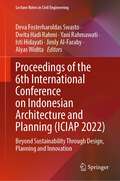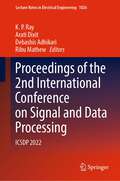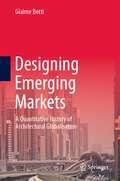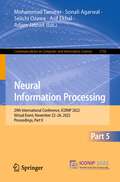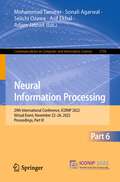- Table View
- List View
Infrastructure and Built Environment for Sustainable and Resilient Societies: Proceedings of IBSR 2023 (Sustainable Civil Infrastructures)
by Arkopal Kishore Goswami Bharath Haridas Aithal Swati Maitra Ankhi BanerjeeThis book presents the select proceedings of the Annual Conference on "Infrastructure and Built Environment: Towards Sustainable and Resilient Societies" (IBSR 2023). It covers the latest research and technologies in the area of smart and sustainable built environment for inclusive societies. Various topics covered in this volume are multimodal urban transport, spatial informatics in urban planning, urban morphology, sustainable transport infrastructure development and many more. This book will be useful for researchers and professionals working in the fields of urban mobility, affordable housing, road infrastructure, and spatial informatics.
Computational Visual Media: 12th International Conference, CVM 2024, Wellington, New Zealand, April 10–12, 2024, Proceedings, Part II (Lecture Notes in Computer Science #14593)
by Fang-Lue Zhang Andrei SharfThis book constitutes the refereed proceedings of CVM 2024, the 12th International Conference on Computational Visual Media, held in Wellington, New Zealand, in April 2024.The 34 full papers were carefully reviewed and selected from 212 submissions. The papers are organized in topical sections as follows:Part I: Reconstruction and Modelling, Point Cloud, Rendering and Animation, User Interations.Part II: Facial Images, Image Generation and Enhancement, Image Understanding, Stylization, Vision Meets Graphics.
Computational Visual Media: 12th International Conference, CVM 2024, Wellington, New Zealand, April 10–12, 2024, Proceedings, Part I (Lecture Notes in Computer Science #14592)
by Fang-Lue Zhang Andrei SharfThis book constitutes the refereed proceedings of CVM 2024, the 12th International Conference on Computational Visual Media, held in Wellington, New Zealand, in April 2024.The 34 full papers were carefully reviewed and selected from 212 submissions. The papers are organized in topical sections as follows:Part I: Reconstruction and Modelling, Point Cloud, Rendering and Animation, User Interations.Part II: Facial Images, Image Generation and Enhancement, Image Understanding, Stylization, Vision Meets Graphics.
Comparative and Decolonial Studies in Philosophy of Education
by David G. HebertThis book introduces the educational philosophies of notable African and Asian thinkers who tend to be little recognized in Europe and North America. It offers specific resources for diversification of higher education curricula. The book expands the philosophy of education, in clear language, to include ideas of major non-western educational thinkers who are little discussed in previous publications. It includes critical analysis of non-western concepts and consideration of their relevance to schools worldwide. The book features discussions of how the work of Tagore and postcolonial thinkers offers diverse visions that increasingly inspire a decolonizing approach to education. This book offers a unique emphasis on how a decolonized philosophy of education can especially enable a rethinking of approaches to education in arts and humanities subjects.
Robotics, Control and Computer Vision: Select Proceedings of ICRCCV 2022 (Lecture Notes in Electrical Engineering #1009)
by Hariharan Muthusamy János Botzheim Richi NayakThis book presents select peer-reviewed papers from the International Conference on Robotics, Control, and Computer Vision (ICRCCV 2022). The contents focus on the latest research in the field of Robotics, their control, and computer vision in the context of robotics. The contributed papers have been arranged to give a flow to the reader. This book will be useful for students, researchers, and professionals from multidisciplinary fields such as mechanical engineering, electronics engineering, electrical engineering, computer science, and mathematics.
Design in the Era of Industry 4.0, Volume 2: Proceedings of ICoRD 2023 (Smart Innovation, Systems and Technologies #342)
by Amaresh Chakrabarti Vishal SinghThis book showcases cutting-edge research papers from the 9th International Conference on Research into Design (ICoRD 2023) – the largest in India in this area – written by eminent researchers from across the world on design processes, technologies, methods and tools, and their impact on innovation, for supporting design for a connected world. The theme of ICoRD’23 has been ‘Design in the Era of Industry 4.0’. Industry 4.0 signifies the fourth industrial revolution. The first industrial revolution was driven by the introduction of mechanical power such as steam and water engines to replace human and animal labour. The second industrial revolution involved introduction of electrical power and organised labour. The third industrial revolution was powered by introduction of industrial automation. The fourth industrial revolution involves introduction of a combination of technologies to enable connected intelligence and industrial autonomy. The introduction of Industry 4.0 dramatically changes the landscape of innovation, and the way design, the engine of innovation, is carried out. The theme of ICoRD’23 - ‘Design in the Era of Industry 4.0’ –explores how Industry 4.0 concepts and technologies influence the way design is conducted, and how methods, tools, and approaches for supporting design can take advantage of this transformational change that is sweeping across the world. The book is of interest to researchers, professionals, and entrepreneurs working in the areas on industrial design, manufacturing, consumer goods, and industrial management who are interested in the new and emerging methods and tools for design of new products, systems, and services.
Deep Cognitive Networks: Enhance Deep Learning by Modeling Human Cognitive Mechanism (SpringerBriefs in Computer Science)
by Yan Huang Liang WangAlthough deep learning models have achieved great progress in vision, speech, language, planning, control, and many other areas, there still exists a large performance gap between deep learning models and the human cognitive system. Many researchers argue that one of the major reasons accounting for the performance gap is that deep learning models and the human cognitive system process visual information in very different ways. To mimic the performance gap, since 2014, there has been a trend to model various cognitive mechanisms from cognitive neuroscience, e.g., attention, memory, reasoning, and decision, based on deep learning models. This book unifies these new kinds of deep learning models and calls them deep cognitive networks, which model various human cognitive mechanisms based on deep learning models. As a result, various cognitive functions are implemented, e.g., selective extraction, knowledge reuse, and problem solving, for more effective information processing. This book first summarizes existing evidence of human cognitive mechanism modeling from cognitive psychology and proposes a general framework of deep cognitive networks that jointly considers multiple cognitive mechanisms. Then, it analyzes related works and focuses primarily but not exclusively, on the taxonomy of four key cognitive mechanisms (i.e., attention, memory, reasoning, and decision) surrounding deep cognitive networks. Finally, this book studies two representative cases of applying deep cognitive networks to the task of image-text matching and discusses important future directions.
Design in the Era of Industry 4.0, Volume 1: Proceedings of ICoRD 2023 (Smart Innovation, Systems and Technologies #343)
by Amaresh Chakrabarti Vishal SinghThis book showcases cutting-edge research papers from the 9th International Conference on Research into Design (ICoRD 2023) – the largest in India in this area – written by eminent researchers from across the world on design processes, technologies, methods and tools, and their impact on innovation, for supporting design for a connected world. The theme of ICoRD’23 has been ‘Design in the Era of Industry 4.0’. Industry 4.0 signifies the fourth industrial revolution. The first industrial revolution was driven by the introduction of mechanical power such as steam and water engines to replace human and animal labour. The second industrial revolution involved introduction of electrical power and organised labour. The third industrial revolution was powered by introduction of industrial automation. The fourth industrial revolution involves introduction of a combination of technologies to enable connected intelligence and industrial autonomy. The introduction of Industry 4.0 dramatically changes the landscape of innovation, and the way design, the engine of innovation, is carried out. The theme of ICoRD’23 - ‘Design in the Era of Industry 4.0’ –explores how Industry 4.0 concepts and technologies influence the way design is conducted, and how methods, tools, and approaches for supporting design can take advantage of this transformational change that is sweeping across the world. The book is of interest to researchers, professionals, and entrepreneurs working in the areas on industrial design, manufacturing, consumer goods, and industrial management who are interested in the new and emerging methods and tools for design of new products, systems, and services.
Indigenous African Language Media: Practices and Processes
by Phillip Mpofu Israel Ayinla Fadipe Thulani TshabanguThe book contributes to the sparse academic literature on African and minority language media research. It serves as a compendium of experiences, activities and case studies on the use of native language media. Chapters in this book make theoretical, methodical and empirical contributions about indigenous African language media that are affected by structural factors of politics, technology, culture and economy and how they are creatively produced and appropriated by their audiences across African cultures and contexts. This book explores indigenous African language media about media representations, media texts and contents, practice-based activities, audience reception and participation, television, popular culture and cinema, peace and conflict resolution, health and environmental crisis communication, citizen journalism, ethnic and identity formation, beat analysis and investigative journalism, and corporate communication. There are hardly any similar works that focus on the various issues relating to this body of knowledge. The book provides a valuable companion for scholars in various fields like communication, media studies, African studies, African languages, popular culture, journalism, health and environmental communication.
Design in the Era of Industry 4.0, Volume 3: Proceedings of ICoRD 2023 (Smart Innovation, Systems and Technologies #346)
by Amaresh Chakrabarti Vishal SinghThis book showcases cutting-edge research papers from the 9th International Conference on Research into Design (ICoRD 2023) – the largest in India in this area – written by eminent researchers from across the world on design processes, technologies, methods and tools, and their impact on innovation, for supporting design for a connected world. The theme of ICoRD’23 has been ‘Design in the Era of Industry 4.0’. Industry 4.0 signifies the fourth industrial revolution. The first industrial revolution was driven by the introduction of mechanical power such as steam and water engines to replace human and animal labour. The second industrial revolution involved introduction of electrical power and organised labour. The third industrial revolution was powered by introduction of industrial automation. The fourth industrial revolution involves introduction of a combination of technologies to enable connected intelligence and industrial autonomy. The introduction of Industry 4.0 dramatically changes the landscape of innovation, and the way design, the engine of innovation, is carried out. The theme of ICoRD’23 - ‘Design in the Era of Industry 4.0’ –explores how Industry 4.0 concepts and technologies influence the way design is conducted, and how methods, tools, and approaches for supporting design can take advantage of this transformational change that is sweeping across the world. The book is of interest to researchers, professionals, and entrepreneurs working in the areas on industrial design, manufacturing, consumer goods, and industrial management who are interested in the new and emerging methods and tools for design of new products, systems, and services.
Personal Comfort Systems for Improving Indoor Thermal Comfort and Air Quality (Indoor Environment and Sustainable Building)
by Faming Wang Bin Yang Qihong Deng Maohui LuoThis book first describes fundamental knowledge on human thermal comfort, adaptive thermal comfort, thermal comfort in sleeping environments, modeling of human thermal comfort, and thermal comfort assessment using human trials. Next, it presents an in-depth review of concept progress and evaluation of various personal comfort system, summarizes important findings and feasible applications, current gaps as well as future research needs. The seven chapters included in this section are task/ambient conditioning systems, personalized ventilation systems, electric fans, personal comfort systems, thermoelectric systems, personal thermal management systems, and wearable personal thermal comfort systems. This book provides valuable guidance for personal comfort system design and further improvement on the personal comfort performance. It will be a valuable resource for academic researchers, engineers in industry, and government regulators in the field of sustainable buildings and built environment.
Data Science and Emerging Technologies: Proceedings of DaSET 2022 (Lecture Notes on Data Engineering and Communications Technologies #165)
by Yap Bee Wah Michael W. Berry Azlinah Mohamed Dhiya Al-JumeilyThe book presents selected papers from International Conference on Data Science and Emerging Technologies (DaSET 2022), held online at UNITAR International University, Malaysia, during December 20–21, 2022. This book aims to present current research and applications of data science and emerging technologies. The deployment of data science and emerging technology contributes to the achievement of the Sustainable Development Goals for social inclusion, environmental sustainability, and economic prosperity. Data science and emerging technologies such as artificial intelligence and blockchain are useful for various domains such as marketing, health care, finance, banking, environmental, and agriculture. An important grand challenge in data science is to determine how developments in computational and social-behavioral sciences can be combined to improve well-being, emergency response, sustainability, and civic engagement in a well-informed, data-driven society. The topics of this book include, but not limited to: artificial intelligence, big data technology, machine and deep learning, data mining, optimization algorithms, blockchain, Internet of Things (IoT), cloud computing, computer vision, cybersecurity, augmented and virtual reality, cryptography, and statistical learning.
Multi-risk Interactions Towards Resilient and Sustainable Cities (Advances in Sustainability Science and Technology)
by Tiago Miguel FerreiraFor years, researchers have studied the risks of individual natural hazards in urban areas. However, the impact of multiple hazards has not yet received widespread attention in research and urban management practice, which is a significant gap in the current climate change context. This book aims to contribute to filling that gap by examining the process of identifying, assessing, and managing multi-hazard risks in urban areas. From identifying and assessing the vulnerability of the elements exposed to the impact of natural hazards, including earthquakes, floods, fires, and landslides, this book covers all the critical stages of multi-hazard risk assessment and management in a climate change context. The concepts and approaches discussed in the book are applied to the Lisbon Metropolitan Area, a dynamic and thriving metropolis, allowing readers to see those theories applied in a real setting. In addition to providing a solid theoretical foundation, this book offers practical guidelines for conducting risk assessment at the metropolitan scale, which makes it a valuable resource for researchers, practitioners, and decision-makers interested in understanding and managing multi-hazard risks in urban areas.
Reimagining Singapore: Self and Society in Contemporary Art
by Chee-Hoo Lum Juliette Yu-Ming Lizeray Chor Leng Twardzik ChingThis book approaches the subject of contemporary art by exploring the social embeddedness and identities of Singaporean artists. Linking artistic processes and production to both personal worlds and wider issues, the book examines how artists negotiate their relationships between self and society and between artistic freedom and social responsibility. It is based on original research into the discourses and artistic practices of local artists, with a special focus on emerging artists and artists whose work and perspectives engage with questions of identity. Reimagining contemporary Singapore and their place within it, artists are asserting their multiple and heterogeneous self-identities and contesting hegemonic norms and notions, as they negotiate and adapt to the world around them. This book is relevant to students and researchers in the fields of cultural studies, media studies, art, sociology of art, arts education, and race and ethnicity studies.
Computer Assisted Music and Dramatics: Possibilities and Challenges (Advances in Intelligent Systems and Computing #1444)
by Ambuja Salgaonkar Makarand VelankarThis book is intended for researchers interested in using computational methods and tools to engage with music, dance and theatre. The chapters have evolved out of presentations and deliberations at an international workshop entitled Computer Assisted Music and Dramatics: Possibilities and Challenges organized by University of Mumbai in honour of Professor Hari Sahasrabuddhe, a renowned educator and a pioneering computational musicologist (CM) of Indian classical music. The workshop included contributions from CM as well as musicians with a special focus on South Asian arts. The case studies and reflective essays here are based on analyses of genres, practices and theoretical constructs modelled computationally. They offer a balanced and complementary perspective to help innovation in the synthesis of music by extracting information from recorded performances. This material would be of interest to scholars of the sciences and humanities and facilitate exchanges and generation of ideas.
Application of Ergonomics in Handicraft: A Laypersons Approach (Design Science and Innovation)
by Prabir MukhopadhyayThis book is about the application of ergonomics in handicraft manufacturing and design keeping in mind the two sets of users, craftsmen and customers buying handicraft items. Written in an easy to understand language and in a story telling format. It requires no prior knowledge of the subject nor any knowledge of science or technology for using this book and applying it in handicraft manufacturing and design. The book starts with an overview of the application of ergonomics in different aspects of craft manufacturing, touching upon tools, space, process and then moves into the aspects of ergonomics of craft packaging and displaying. Alongside the book also explains the ergonomic aspects of designing of handicraft products keeping the users of the products in mind, their dimensions, capacity, limitations etc. Each chapter starts with an "overview" and ends with "key points" and exercises to help the readers in applying the principles of ergonomics in handicraft. The last chapter is dedicated to exercises in different areas of handicraft and the ergonomic applications for them, followed by ergonomic design directions to solve them.
Proceedings of the International Conference on Emerging Smart Cities (Lecture Notes in Civil Engineering #324)
by Bashar S. Mohammed Teh Hee Min Muslich Hartadi Sutanto Tri Basuki Joewono Sholihin As’adThis book contains papers presented at the International Conference on Emerging Smart Cities (ICESC2022), previously known as the International Conference on Civil, Offshore and Environmental Engineering (ICCOEE). ICESC is held under the banner of World Engineering, Science and Technology Congress (ESTCON2022) from 1 to2 December 2022 at Borneo Convention Centre, Kuching, Sarawak, Malaysia. This proceeding contains papers presented by academics and industrial practitioners showcasing the latest advancements and findings in civil engineering areas with an emphasis on emerging smart cities for the ultimate shape of urban living in the near future. The papers are categorized under the following tracks: (1) Climate Adaptive materials; (2) Environmental sustainability; (3) Infrastructure efficiency.
Art, Science, and Diplomacy: A Study of the Visual Images of the Macartney Embassy to China, 1793
by Shanshan ChenThis book examines how the Embassy members approached, selected, and represented information, and how, in doing so, they helped to shape European perceptions of China. The Macartney Embassy of 1793 was the first British diplomatic mission to China, seeking to open ties between the two empires. As part of the mission, the British government commissioned writers and artists to chronicle the geography and culture of a civilization that had, until then, been shrouded in mystery. A central focus of the book is the artwork itself, which provides a window into the diplomatic, artistic and scientific viewpoints underlying the mission. Drawing on archival research, the study recreates the processes through which the Embassy’s draughtsmen, scientists, and diplomats collaborated to represent the visual images, and how the materials were reworked for publication in London. The finished product demonstrates that the artists offered a distinct viewpoint in the representation of China, sometimes differing from the textual accounts, by blending scientific elements and artistic aesthetics in order to demystify China and make it more knowable to a British audience. It was in the interposition of text and image that the British public formulated an ambivalent perception of China that embraced both admiration and disdain. In addition to the scholars, the book targets general readers who are interested in global art and history, and East–West interactions. It contains important images with detailed visual and historical analysis that enable readers to acquire knowledge on how the British represented China and how that image helped to shape the European perception of China during the British global expansion in the eighteenth and nineteenth centuries, and beyond.
Large-Eddy Simulation Based on the Lattice Boltzmann Method for Built Environment Problems
by Mengtao Han Ryozo OokaThis book details the lattice Boltzmann method (LBM) applied to the built environment problems. It provides the fundamental theoretical knowledge and specific implementation methods of LBM from the engineering perspective of the built environment. It covers comprehensive issues of built environment with three detailed cases, solving practical problems. It can be used as a reference book for teachers, students, and engineering technicians to study LBM and conduct architecture and urban wind environments simulations, in the fields of architecture, building technology science, urban planning, HVAC, built environment engineering, and civil engineering.
Recent Developments in Energy and Environmental Engineering: Select Proceedings of TRACE 2022 (Lecture Notes in Civil Engineering #333)
by Rafid Al Khaddar S. K. Singh N. D. Kaushika R. K. Tomar S. K. JainThis book comprises select proceedings of the International Conference on Trends and Recent Advances in Civil Engineering (TRACE 2022). It discusses the latest topics related to energy and environmental engineering. The topics covered include green and clean technologies, zero-energy buildings, solar energy, energy conservation and heat recovery, solar architecture, artificial intelligence for sustainable buildings, climate change, and plastic and air pollution. This book is useful for researchers and professionals working in the area of civil engineering and energy and environmental engineering.
Proceedings of the 6th International Conference on Indonesian Architecture and Planning: Beyond Sustainability Through Design, Planning and Innovation (Lecture Notes in Civil Engineering #334)
by Deva Fosterharoldas Swasto Dwita Hadi Rahmi Yani Rahmawati Isti Hidayati Jimly Al-Faraby Alyas WiditaThis book presents selected papers from the 6th International Conference on Indonesian Architecture and Planning (ICIAP) held during October 13-14 2022 at the Universitas Gadjah Mada, Yogyakarta, Indonesia. The ICIAP is a series of biennale conferences which presents the latest developments in the field of Indonesian architecture, planning, and the governance. Each edition of the conference focuses in a specific theme, and it provides an exclusive forum for intellectually stimulating and engaging interactions among academicians and industrialists to share their recent scientific breakthroughs and emerging trends. For ICIAP 2022, the conference theme focused on “Beyond Sustainability in Design, Planning, and Innovation” and papers presented on relevant topics such as sustainable urban and regional development, sustainable architectural design, innovations for sustainability, responsive environment and challenges for sustainability. The content of this book will appeal to the researchers, academics, urban planners and policymakers who work in the field of sustainable architecture design, planning and innovation.
Proceedings of the 2nd International Conference on Signal and Data Processing: ICSDP 2022 (Lecture Notes in Electrical Engineering #1026)
by K. P. Ray Arati Dixit Debashis Adhikari Ribu MathewThis volume comprises the select proceedings of the 2nd International Conference on Signal & Data Processing (ICSDP) 2022. The contents focus on the latest research and developments in the field of artificial intelligence & machine learning, Internet of things (IoT), cybernetics, advanced communication systems, VLSI embedded systems, power electronics and automation, MEMS/ nanotechnology, renewable energy, bioinformatics, data acquisition and mining, antenna & RF systems, power systems, biomedical engineering, aerospace & navigation. This volume will prove to be a valuable resource for those in academia and industry.
Designing Emerging Markets: A Quantitative History of Architectural Globalisation
by Giaime BottiThis book offers a unique glance into the process of globalisation of the architectural practice during the last three decades through the lenses of innovative methodologies in architectural history based on quantitative data. Focusing on the golden age of globalisation (1990-2019), it investigates the transnational work of more than one thousand architectural firms of different business models from Europe, North America, and the Asia-Pacific in a broad sample of emerging markets: Mainland China, South-East Asia, India, the Persian Gulf, Sub-Saharan Africa, Russia and Kazakhstan, and Latin America. In the book, different thematic geographies are presented to explore the global scope of the contemporary profession, examine significant projects and the structural conditions behind them, and reveal the debates that such works generated. Understanding the global agency of design firms in emerging markets also becomes a way to study different market conditions, modes of production, and architectural trends comparatively and to highlight the shifts that occurred in the profession over the last few decades. The use of quantitative methodologies produces a novel and updated narrative on contemporary architecture in emerging markets grounded in quantitative data rather than in preassumptions and purely qualitative interpretations. Richly illustrated, this book is further enhanced by an ample set of maps, graphs, and tables to visualise data better.
Neural Information Processing: 29th International Conference, ICONIP 2022, Virtual Event, November 22–26, 2022, Proceedings, Part V (Communications in Computer and Information Science #1792)
by Mohammad Tanveer Sonali Agarwal Seiichi Ozawa Asif Ekbal Adam JatowtThe four-volume set CCIS 1791, 1792, 1793 and 1794 constitutes the refereed proceedings of the 29th International Conference on Neural Information Processing, ICONIP 2022, held as a virtual event, November 22–26, 2022. The 213 papers presented in the proceedings set were carefully reviewed and selected from 810 submissions. They were organized in topical sections as follows: Theory and Algorithms; Cognitive Neurosciences; Human Centered Computing; and Applications.The ICONIP conference aims to provide a leading international forum for researchers, scientists, and industry professionals who are working in neuroscience, neural networks, deep learning, and related fields to share their new ideas, progress, and achievements.
Neural Information Processing: 29th International Conference, ICONIP 2022, Virtual Event, November 22–26, 2022, Proceedings, Part VI (Communications in Computer and Information Science #1793)
by Mohammad Tanveer Sonali Agarwal Seiichi Ozawa Asif Ekbal Adam JatowtThe four-volume set CCIS 1791, 1792, 1793 and 1794 constitutes the refereed proceedings of the 29th International Conference on Neural Information Processing, ICONIP 2022, held as a virtual event, November 22–26, 2022. The 213 papers presented in the proceedings set were carefully reviewed and selected from 810 submissions. They were organized in topical sections as follows: Theory and Algorithms; Cognitive Neurosciences; Human Centered Computing; and Applications.The ICONIP conference aims to provide a leading international forum for researchers, scientists, and industry professionals who are working in neuroscience, neural networks, deep learning, and related fields to share their new ideas, progress, and achievements.

